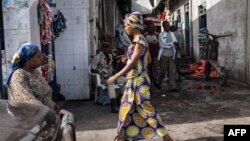The Democratic Republic of Congo’s government has signed up for a new plan to stabilize North Kivu, the DRC province with the worst levels of violence and insecurity. The plan's authors say it involves more local consultation than previous plans.
The plan is really a continuation of a stabilization and reconstruction program known as STAREC that was launched in 2009 and ran out of funding three years later.
By then donors had lost confidence in the program, owing to renewed conflict but also flaws in its design and implementation.
The program covered five provinces of eastern Congo and more than $200 million was spent, mainly on building or repairing more than 100 police stations and government buildings, reopening 1,400 kilometers of roads and training about 1,500 police and officials.
Inadquate first program
STAREC’s national coordinator, Alain Kashindi Assumani, tells VOA the first phase of the program had limited results because it did not meet the population’s real needs.
STAREC One addressed the consequences but not the causes of conflict, he says. For example, instead of attacking poverty, which is one of the causes of conflict, it concentrated on repairing damage caused by warlords.
A spokesman for civil society groups in North Kivu, Djento Maundu, agrees.
"The biggest problem with the first phase of STAREC is that it didn’t include a strategy for directly attacking poverty, which is the machine producing the armed groups destabilizing eastern Congo," he said.
Consulting local people
The new strategy for North Kivu and the other provinces is based on consultation with many people in the affected areas.
One of the non-governmental organizations carrying out these consultations is International Alert.
Maria Lange, International Alert's director in the DRC, thinks STAREC Phase One had several shortcomings.
"I have come across projects where a prison was built that didn’t have any bars, for example. You know, there were some examples of just really poor project execution," she said. "Some things were done well, but I think the lack of engagement by the Congolese government was definitely one of the main problems, as well as lack of actually asking the communities what they need. "
STAREC has admitted that some of the police stations and offices that it built have been under-utilized, as not enough police or officials were deployed to those places.
The new strategy calls for ongoing democratic dialogue to ensure that projects meet people’s needs, and to make the government more accountable to its citizens.
Political culture
Changing the political culture may be harder to achieve than reducing poverty in some of Kivu’s villages, but Lange believes those two aspects of the program have to go together.
"There might be less interest by certain parts of government in the whole democratic dialogue aspect of the strategy, but I think past experience, including STAREC Phase One, demonstrates that it’s a very necessary component of development," she said.
The stabilization strategy is just one of several blueprints aimed at achieving lasting peace in eastern Congo. There is also a program to demobilize Congolese armed groups, which the government has been urged to reactivate, and a peace and security agreement which the DRC signed with neighboring countries, including Rwanda and Uganda.
International Alert is calling for the dialogue around STAREC Phase Two not to ignore those countries.
"It should evidently include neighboring countries as well, that are signatories to that, and I think we haven’t seen very much progress on that front so far," said Lange.
The DRC government, the United Nations and donors have been talking about the second phase of STAREC for three years and it sounds as if there is a lot more talking still to come.










